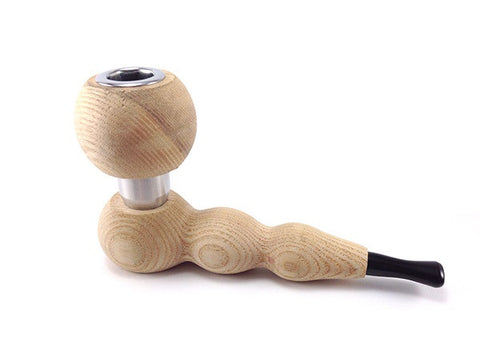Vapor Genie Review: C+
Buy this product online

This is the “Bare Naked Maple” version of the Classic Vapor Genie Pipe. It’s the most analog and one of the cheapest vaporizers on the market. So if you’re on a budget or the type that’s into keeping things battery-less and simple, you might be interested.

It’s about 5 inches long and 3 inches tall at the bowl. Made simply out of wood and stainless steel (certain models are colored or have a different wood-finish), coupled with the classic functionality and look of a pipe, I can appreciate the organic aesthetic and it’s really familiar and easy to use. Although, since you’ll be using a BIC-type butane lighter to heat the heating element yourself, it requires a slight learning curve.

It breaks down into only two pieces. The bottom, which consists of the mouthpiece, pipe stem, and bowl, and the top, the spherical encasement of the heating element — a ceramic filter made of silicon carbide.

According to Vapor Genie, the ceramic filter contains no metal, so as to not contaminate the vapor, and that it never deteriorates so it doesn’t need to be replaced if properly used. Properly used meaning not over-packing the herb or getting soot build-up in the filter.

When this top is screwed back onto the bowl, the ceramic filter will sit more or less right on top of your freshly loaded herbs in the bowl. Be careful not to over-pack the bowl or else the ceramic filter will be touching the herb, causing the herb to more likely combust and smoke. As you can see, the bowl has about just as much space for herb as a glass pipe of a similar size. The bowl also has a metal screen, the only replaceable part of this pipe.
Now onto the fun part.

You may be asking, “How do I use it? Does it work?” It works. Not as efficiently and smoothly as the electronic products on the market, but it definitely works.
It also works like a pipe, only this time your goal is to not let the herb catch on fire. That’s the part that takes practice and getting used to, and the part that shows just how analog this vaporizer is.
You get a simple butane lighter, such as a BIC brand lighter, and while holding it ignited over the bowl, you steadily inhale and drag the flame into the bowl without letting it actually touch the filter. It’s easy to do once you get a hang of how hard you drag. The harder you drag/inhale, the cooler the temperatures actually get in the filter so I find the best results by dragging smooth and slow, with medium intensity. This lets the filter get hot enough to vaporize the herb, and I can also tell just by the heat of the vapor I’m inhaling. If it’s too hot to inhale, you can bet you’re burning the herb too, and it’ll be evident by smoke. You’ll definitely feel, and taste the difference.
VaporGenie suggests taking smooth, sustained drags for several seconds at a time. This works well, although I run out of room in my lungs in half the time. Others find the best results inhaling in short, quick, consecutive bursts. It’ll be different for everyone, and for the herb. Depending on the consistency and moisture of different kinds and strains of herb, results may vary slightly.
In my experience, a bowl will last between 5-10 hits. Hemp wick won’t work as an alternative fire source as the power of your own inhale will put the flame out. A torch lighter would work, but it burns way too hot for the lungs and herb, and you’d risk burning yourself while you hold the pipe in your hand. Don’t do it.
Pros
- Good looking organic wood aesthetics and appeal. Real, natural wood and stainless steel finish. (Colors available)
- Well-built and sturdy. Only screens would need to be replaced periodically.
- Battery-less. Never have to recharge.
- Simple, and easy to use.
- Only requires a lighter. (Will still be useable during an Apocalypse)
Cons
- Not discreet. Looks like a pipe, and using it is similar to using a pipe.
- Bulky, and not very portable.
- Butane-Lighter powered. You have to be willing to inhale butane lighter fumes and possible impurities during the process.
- Inconsistent vapor (imperfect process because of the human factor).
- Inconsistent dosage. Hard to figure out the proper dosage as all herbs and their different strains will vaporize differently and inconsistently through the process. Hard to know how many hits to take.
- You have to mix the herb in the bowl around a bit after a couple hits.
Conclusion: This is a great choice for someone who’s on a tight budget or someone who’s looking for the most simple, no-frills or thrills kind of vaporizer. Being battery-less and only requiring a lighter, maybe a survivalist looking to still be able to vaporize during an Apocalypse or electricity-blackout scenario would consider this.
The build quality and look of the natural wood is great on the pipe, but it’s not for someone who’s trying to be discreet and on the go. It’s also not for someone who’s looking for efficient and consistent dosage in their vaporizer.
The VaporGenie does vaporize, and it can do it well, but not very efficiently or consistently since it depends on so many factors. Those factors being the user’s own inhales/drags, the consistency and moisture levels of the herb, the different strain of the herb, the proximity of the lighter, and so on. But if you’re a casual user or just on a budget, or just want to dip a toe in the world of vaporizers, the VaporGenie could very well be your entry-level vaporizer. But for the same price range, it can’t really compete with that’s available on the market today. For the same price range, you could get yourself a more discreet vaporizing pen that will produce consistent and better quality vapor from your herb or concentrates. If you’re willing to drop a little more dough, I’d recommend the MFLB as an intro vaporizer.
Reviewed by Brent K on April 8, 2015
 $55.00
$55.00
